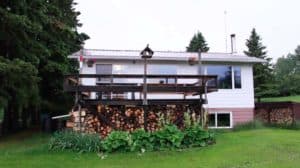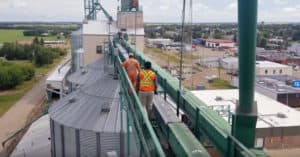Communities across western Canada don’t need to reinvent the wheel to revitalize their economies. Rural Canadians have long dealt with challenges by rolling up their sleeves and a can-do attitude.
Do-It-Yourself rural economic development is also tried and true, and has played a significant role in western Canada’s growth. We all know the stories of people coming together to raise a barn or fence. But often people have also worked together to create businesses. Some of these businesses became retail stores and global grain marketing firms. Others helped secure utilities and services, such as electricity and seed cleaning.
Our favourite example of DIY economic development is a group of southern Saskatchewan farmers who saved their own livelihoods during the Great Depression. Their efforts eventually created one of the prairies’ most significant rural economic drivers on the prairies.
Fueling Western Canada
In the 1930s, Canadian farmers were phasing out horses in favor of tractors. But, thanks to macro-economic factors outside their control, the petroleum required to fuel tractors was a far cry more expensive than the fuel for horses. Between hard-hitting drought and a financial crisis that made wheat prices plummet, farmers were in a tough spot.
Instead of letting the crisis get the best of them, eight farmers came together in 1934, pooled their money, bought a skimming plant, and started producing their own fuel. And so, the seeds of the Co-op Refinery Complex (CRC) were planted.
After a series of mergers in the 40s, the refinery co-op became part of the Co-operative Retailing System and managed by Federated Co-operatives Limited. Today, the CRC employs over 1,000 people and pumps billions of dollars and millions of litres of fuel into rural agricultural economies across western Canada each year. And it all started as a DIY project.
Not to be outdone, rural people in 1940s Alberta hoping to get electricity in their farmhouses created Rural Electrification Associations (REAs) — aka power co-operatives – after both the government and private sector decided getting power to rural areas was too expensive. While many of these co-ops have been purchased by large utility firms, some of these REAs still exist, providing a valuable service to their members and giving back to their communities where they can.
Connecting Rural Communities to the Future
But DIY solutions aren’t a thing of the past. Rural communities still need a can-do approach to development — just like in the 1930s and 40s.
So what’s the modern equivalent of farmers building their own oil refinery or power grid? You can find examples everywhere.
Broadband today is just as important to economies as electricity was 80 years ago — and communities like Hamiota, Manitoba and Olds, Alberta have provided themselves with some of the fastest internet around.
And speaking of forward-thinking, a growing number of communities are creating their own sources of renewable power. The Peace Energy Co-operative’s large solar and wind installations in Dawson Creek, BC puts its region ahead of the curve.
The Importance of Investing in yourself
Beyond renewables and broadband, the challenge of attracting new people and the sustainability of the small business community are often top of mind. Young, local entrepreneurs might have a great idea for a business that could give their community a boost — but without investment they might never get it off the ground. Communities across western Canada face these same challenges. A few have a DIY answer.
With banks not there to provide a loan and investors being scarce, Sangudo, Alberta, Creston BC, and the West Interlake region of Manitoba chose to do it themselves by starting investment co-ops. These innovative co-operatives give local residents a way to pool their money and invest it in local businesses and services.
And investing in yourself can be the spark that encourages others to invest in you.
Lana Cowling-Mason, the General Manager of Community Futures West Interlake, summed up the need for DIY rural development in her region.
“If you’re going to sit back and wait on someone to solve the needs of the community, then we’re going to be waiting a long time,” she said. “If you’re not prepared to invest in yourself, then why the heck would anybody else?”
Like those farmers who couldn’t wait for others to improve their situation in the 1930s and 40s, community leaders today know they can’t afford to wait on others to rejuvenate their towns. They have to do it on their own terms — and often, forming a co-op is the solution.
What does DIY development look like for you?
Since you’re still reading, odds are you’re an invested community member and have ideas about what could benefit you or your community. Maybe it’s a utility or some form of infrastructure. Maybe it’s a store, or a way for business owners to work together to lower their expenses. Or maybe it’s a community garden or recreation facility. Whatever it is, you’re probably right and you should do it. You know more about your community than any investor or entrepreneur from a city miles away — that’s your hometown advantage. And ideas like that are worth pursuing.
However, just because it’s “do-it-yourself rural development” doesn’t mean do-it-alone. Rural development is a team effort, and starting a co-operative is a great way to work together to make things happen. Plus, you have us. Our team at Co-operatives First is here to help leaders like you start co-ops. Contact us to learn more.

 Written by
Written by 


